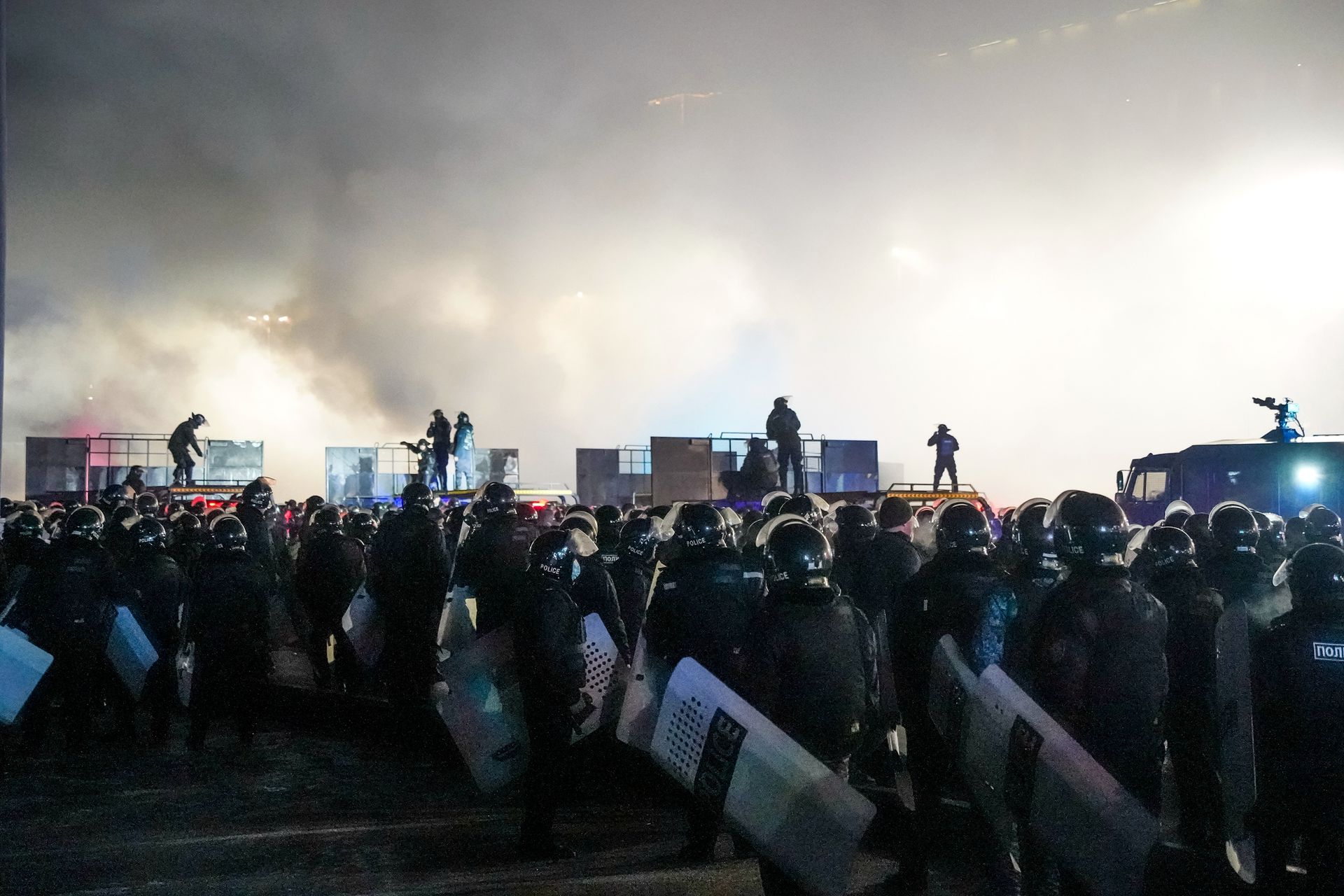The January uprising in Kazakhstan, and particularly in Almaty, was the most notable event in the living memory of most Kazakhstanis. In his address to the extraordinary session of the CSTO [Collective Security Treaty Organisation], the president, Kasym-Jomart Tokayev, described it as “the heaviest crisis in the whole 30-year history of independence”. This was the first time that the bourgeois regime of modern Kazakhstan has ever faced such a threat.
In a matter of days, the whole country became engulfed in protests of a truly revolutionary and – most importantly – nationwide scale. This shook the ground beneath both ‘presidents’, their oligarchs and their guard dogs. It is true that this mighty movement has (temporarily) been drowned in blood. But even this required the summoning of foreign forces of intervention.
The predecessor of the current president gained infamy as ‘the butcher of Zhanaozen’. His successor should rightfully be known from now on as ‘the butcher of the Republic’. Kazakhstan will never be the same. Alongside the events of 2011 in Zhanaozen; the ‘land demonstrations’ of 2016; and the protests of 2019, the events of January this year represent a further stage in the eruption of the fundamental contradictions of Kazakhstan and of world capitalism. These events are progressively preparing the ground for the development of an organised mass movement, which will finally tear down the whole rotten capitalist edifice and build a new society upon its ruins.
Chronicles of the uprising
Mass protests against fuel price increases in Kazakhstan began in the western part of the country, in the Mangystau region, after a liberalisation of liquefied petroleum gas (LPG) prices was announced. This led to a price hike from 50-60 tenge [Kazakhstani currency] per litre to 120 tenge and above. In this oil-producing region, LPG – or ‘autogas’ – is widely used as fuel for vehicles, as well as for cooking and heating. On 2 January in Zhanaozen – a city with a rich labour and trade union movement tradition – residents came out onto the streets in protest at the rise in prices. On the same day, protests spread throughout the region, including its administrative centre Atyrau, where protesters began putting up tents and yurts on the central square.
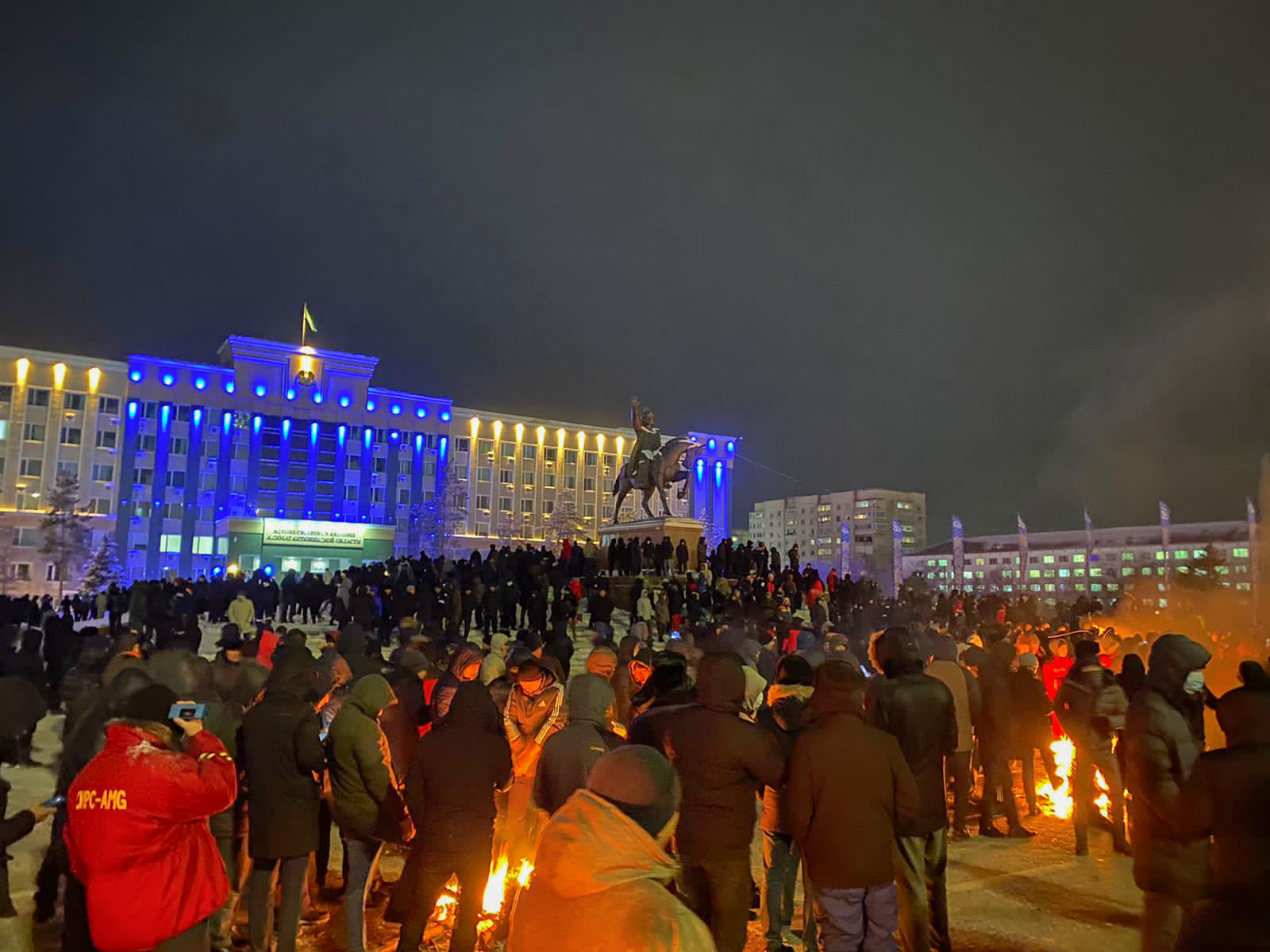 The January uprising in Kazakhstan, and particularly in Almaty, was the most notable event in the living memory of most Kazakhstanis / Image: Esetok, Wikimedia Commons
The January uprising in Kazakhstan, and particularly in Almaty, was the most notable event in the living memory of most Kazakhstanis / Image: Esetok, Wikimedia Commons
On 3 January, strikes broke out at the oilfields. In an attempt to stop the spread of the movement, the management of the oil companies refused to transport the workers back to their homes, forcing them to walk tens of kilometres through the frozen desert. The oil workers demanded a 100 percent increase in their wages, and improvements in their working conditions. The workers not only put forward economic demands, but also raised political demands, specifically for the legalisation of political parties and independent trade unions. Pickets of solidarity with the protesters of Mangystau started to gather throughout the country. By morning, the strike in the Mangystau region had become generalised, and was also joined by the Tengizchevroil oil workers of the Atyrau region.
It is telling that, initially, the responsible ministry stated, quite correctly, that neither the local administration nor the government determine prices, but rather that the price increase was a result of market forces. But soon the government back-tracked, announcing it would regulate autogas prices and investigate possible price fixing by the owners of petrol stations. In an agreement with the government, the latter agreed to temporarily reduce prices to 85-90 tenge per litre – which was still significantly higher than the 50 tenge per litre demanded by the protesters.
But the government’s minimal concessions did not have the desired effect. On 4 January, the protests spread throughout the country. In the industrial areas of the Karaganda region of central Kazakhstan, strikes broke out among the miners of ArcelorMittal Temirtau, and among the metalworkers and miners of the Kazakhmys corporation. Workers of the Karaganda foundry and machine-building plant – like the oil workers – demanded a 100 percent increase in wages, an increase in paid leave, free meals at work, and additional pay and pension benefits for those working in hazardous conditions. In addition, the strikers demanded the dismissal of the plant director.
In almost all of the regional administrative centres, groups numbering from hundreds to tens of thousands of people flowed into the main city squares. Citizens coming to express their solidarity with Zhanaozen, and united by a common discontent with the state of affairs in the country, quickly began collectively formulating their demands. Most of them were inspired by the demands put forward in Mangystau, both economic (end inflation and rising prices, increased wages, a loan amnesty) and political (democratic reforms, dismissal of the government and president, dissolve parliament, new elections, release of political prisoners).
For the majority of the participants, this was their first experience of political struggle; but practice is a great teacher, and the fact that such a clear, healthy, social and democratic agenda formed so quickly is striking proof of that. The protesters showed not only great consciousness and discipline, actively suppressing the actions of police provocateurs, but also impressive determination to stand until the end, refusing to accept the excuses of frightened bureaucrats and refusing to leave the city squares.
By the evening of 4 January, tens of thousands of people had gathered on the streets of Zhanaozen and Aktau. But by that point, events had reached their highest intensity on the streets of Almaty. In the first days of the protest, the police of Almaty and of the capital had successfully acted preemptively: city squares were cordoned off, mobile internet was jammed in city centres, and many activists were detained right as they left their houses. But by the afternoon of 4 January, the squares of Almaty – in particular Republic Square, where the city administration is located – had started to fill up with crowds of protesters.
Decisively, besides the usual politicised layers of the former capital, workers and youth of the outskirts and suburbs of Almaty entered the scene. Their main point of assembly was the Almaty Arena stadium, located in the west of the city, where the poorest areas of the southern capital are concentrated. These are often compared to ghettos and South American favelas. A crowd of tens of thousands of people proceeded towards Republic Square, swelling with new participants along its 1.5-hour route.
Fierce street fighting was initiated by the Almaty police. Similar scenes engulfed a number of cities across the country over several days. Security forces met the stream of people approaching the square with clubs, flash grenades and tear gas. The same weapons were then used against the protesters in the square where the city administration buildings are located. Soon, rubber bullets were also being deployed. The state, having declared war on its own citizens, was met with fierce resistance, which quickly turned into a counter-offensive. For several days, the city was filled with the sound of explosions and gunshots. The acrid smell of tear gas engulfed the historic centre of Almaty, and the square was illuminated by burning police vehicles and a fire in the main administration building, which the enraged rebels had succeeded in breaking into.
By the night of 4 to 5 January, it had become clear that the police and the National Guard could not suppress the protest. Many members of the security forces had been beaten up and disarmed. Realising that the ground was slipping from under the feet of the whole regime, Tokayev announced the dismissal of the government, and declared a state of emergency and a curfew in Almaty and the Mangystau region, later expanding it to the whole country. Neither concessions nor intensified repression could help the regime. By the late evening of 4 January, word of the carnage in Almaty had spread throughout the country. Mass clashes with the security forces (with the use of firearms on both sides) and the smashing up of administrative buildings (police stations, local administrations, ruling party offices) spread to cities across the country to one degree or another.
The clashes between protesters and the police continued on 5, 6 and 7 January in Almaty, as well as in a number of cities of southern and western Kazakhstan, including Kyzylorda, Taraz, Shymkent, Aktobe, and Taldykorgan, where the rebels managed to tear a huge statue of Nazarbayev down from its pedestal. On 5 and 6 January, the police and the National Guard were passive and had clearly ceded the initiative on the streets to the protesters. In Almaty, the police were completely absent from the streets in most parts of the city in those days. In other cities, some members of law enforcement and of the armed forces refused to carry out orders to suppress the protests; and there were instances of fraternisation. The KNB (Committee of National Security) had clearly abstained from any participation in the confrontation; everything indicated that this was a conscious decision on the part of their leadership, though clearly not out of solidarity with the protests!
Despite the fact that the initial uprising had been successfully suppressed in the capital, by 5 January it seemed as though the end of the regime was imminent, and that the nearly-completed takeover of Almaty by the rebels was just a step towards the complete overthrow of the current government. In a televised address, president Tokayev declared himself chairman of the Security Council without any explanation – a post reserved for life to Nazarbayev!
He then unleashed a brutal crackdown on the protest movement, whose participants he labelled as “paid conspirators”. However, the streets were still under the complete control of the rebels. Small numbers of security forces personnel that remained reliable concentrated in the besieged police headquarters and in the Almaty presidential residence. Unlike in other cities, Almaty saw a relatively large wave of looting, which frightened well-off members of the public and moralising liberals, who predictably rushed to defend private property, shopping centre windows, and electronics stores, and to distance themselves from the “savages” and “riff-raff”.
On the night of 5 to 6 January, after lifting the countrywide internet blackout for a few hours, the government announced its decision to summon ‘peacekeepers’ from the CSTO – predominantly Russian troops. Their rhetoric with regards to the protest movement became even harsher: they declared the rebels to be terrorists and announced the start of a “counter-terrorist operation”. Only after the regime redeployed military forces from other regions to the Almaty area, and after the CSTO contingent secured a number of strategic locations, was Tokayev able to suppress the resistance of the masses. A breaking point in the revolutionary drama came with the shooting of several hundred peaceful demonstrators who had remained in Republic Square on the evening of 6 January. Smaller clashes and shootouts continued in Almaty and the surrounding region over the next few days, but gradually people began leaving the streets and squares across the country. Some of them went home; others went into hiding; and several hundred civilians were killed in those days (the exact number remains unknown).
From almost the very beginning, the regime has tried to frame the rebels as “foreign terrorists” or, at best, as pawns in some kind of conspiracy. The police-bureaucratic logic of the state is usually incapable of comprehending such events in any other way. Of course, there are divisions in the Kazakh ruling class. And once the masses entered the scene, some individuals and groups within the ruling class saw an opportunity to use the movement to advance their own interests.
But to reduce everything to the jostling of factions within the ruling class – as the media have done – is to ignore the fact that it was the movement of the masses on the street that was the motor force of events. The various ‘experts’ and political commentators are trying to derail the conversation about the social nature of the protests precisely by focussing entirely on the question of palace intrigues and factional disputes within the elite, reducing the masses to a position of insignificance by comparison.
Such a view of history that focuses exclusively on the manoeuvres of individuals, or worse on a conspiracy of shadowy actors manipulating the masses like a puppeteer, are worse than useless in explaining these revolutionary events. What is needed is a materialist analysis that draws out the roots of the process now unfolding: roots that are to be found in the historical and socio-economic conditions of modern Kazakhstan.
History of Kazakhstan
Modern Kazakhstan is the southern part of the region known as the ‘Great Steppe’: a wide strip of grassland plains between the Siberian taiga and the Central Asian deserts. For many centuries, Turkic tribes migrated northwards through this area annually, crossing the steppe and forest-steppe in spring, and returning in autumn and winter to the very edge of the desert and foothills.
The Kazakh Khanate emerged here as a result of the disintegration of the Golden Horde (a Tartar and Mongol army, led by descendants of Genghis Khan) and the Uzbek Khanate in the middle of the 15th century. To the north, in the forest-steppe, there was the Siberian Khanate; to the south, beyond the desert and mountains, the Bukhara Khanate; to the east, the Dzungar Khanate, with which Kazakhs fought endless and exhausting wars in the 17th-18th centuries. Around the same time, three large associations of Kazakh clans emerged: the Senior, Middle, and Junior Zhuz in the south-east, north-east, and west of Kazakhstan respectively.
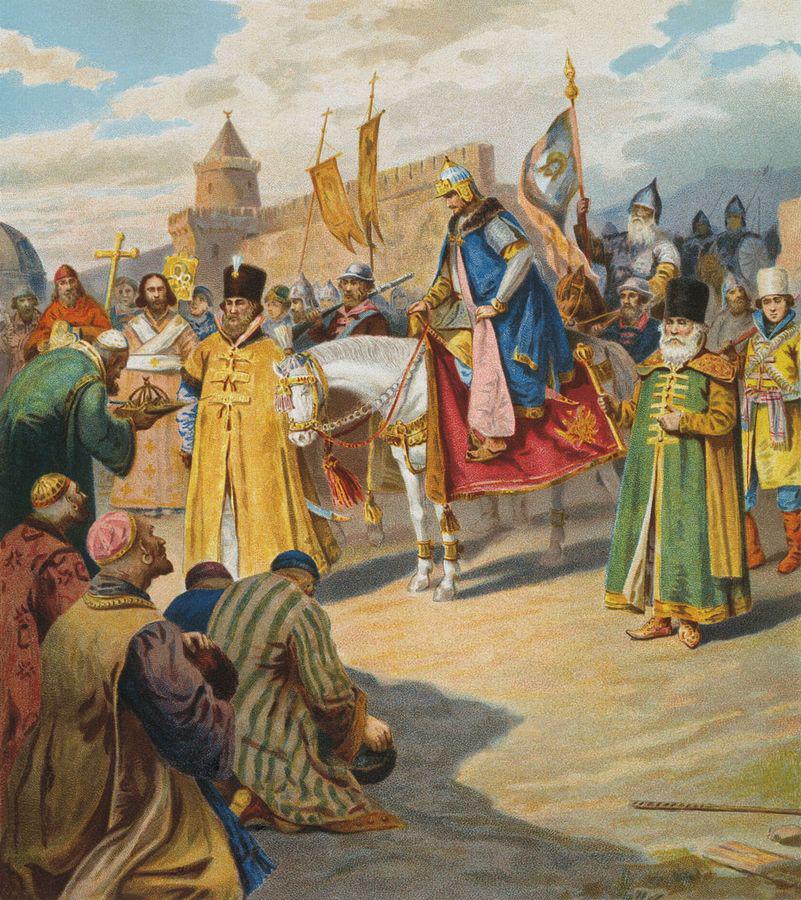 Kazan and Astrakhan Khanates were annexed into the Grand Duchy of Moscow in the 16th century by Tsar Ivan IV the Terrible / Image: public domain
Kazan and Astrakhan Khanates were annexed into the Grand Duchy of Moscow in the 16th century by Tsar Ivan IV the Terrible / Image: public domain
Meanwhile, in the middle of the 16th century, Tsar Ivan IV the Terrible – after a period of warfare – annexed the Kazan and Astrakhan Khanates into the Grand Duchy of Moscow. At the end of the same century, after the Yermak campaign (named for Yermak Timofeyevich, the cossack ataman, or military commander, who led Russia’s conquest of Siberia), the Siberian Khanate fell, and Russian colonisation of Siberia began.
Using typical Russian colonisation tactics, in the middle of the 18th century, the Russian imperial government decided to construct the Orenburg, Uysk and Siberian borderlines, consisting of fortresses and Cossack-populated settlements. These lines then gradually shifted southwards, displacing the nomadic Kazakhs from their summer pastures. One of the consequences of the tsarist colonial policy was the support by the majority of tribes of the Junior Zhuz of a peasant revolt led by Yaik Cossack ataman Yemelyan Pugachev in 1773-1775.
At the time, Russian and Ukrainian peasants avoided settling in the arid steppes, which were considered risky for farming. Thus, the northern border of modern Kazakhstan was drawn. The final annexation of Kazakhstan into the Russian Empire was a result of the Russian-Kokand war of 1850-1868, in which Russian imperialism took most of the fertile and densely populated regions of Central Asia: Bukhara and Khwarazm.
The Kazakh steppes found themselves within the Empire, and despite the fierce resistance of the steppe inhabitants, primarily led by Syzdyk Sultan, they were incorporated into it. The exception was Zhetysu in the south-east – where the foothills enjoyed enough rainfall for intensive agriculture. The Kirghiz and Kazakh population who were engaged in crop growing here, were displaced by Russian migrant colonists: first the Cossacks, and later peasants. It was here that the fortress of Verny was founded in 1854. After the revolution it was renamed Alma-Ata [now Almaty].
The brightest page in the struggle of the Kazakh people against tsarism was written in 1916, when a revolt erupted over the requisitioning of cattle, and the mobilisation of Kazakhs for works related to the First World War. The uprising was most violent in Semirechye (Zhetysu). Its leader was Tokash Bokin, an interpreter in the Semirechye Regional Resettlement Department, and later one of the organisers of Soviet power and secretary of the Military-Revolutionary Committee of the Soviets.
The uprising also engulfed the Turgai region, where the uprising was led by Amangeldy Imanov, who inflicted a number of defeats on Russian troops sent to carry out punitive action. The uprising in Turgai lasted from the summer of 1916 until the capture of Turgai in late 1917, when Soviet authority was established in the area. Like Tokash Bokin, Imanov was assassinated in 1918 by members of the Alash Party, the Kazakh Cadets.
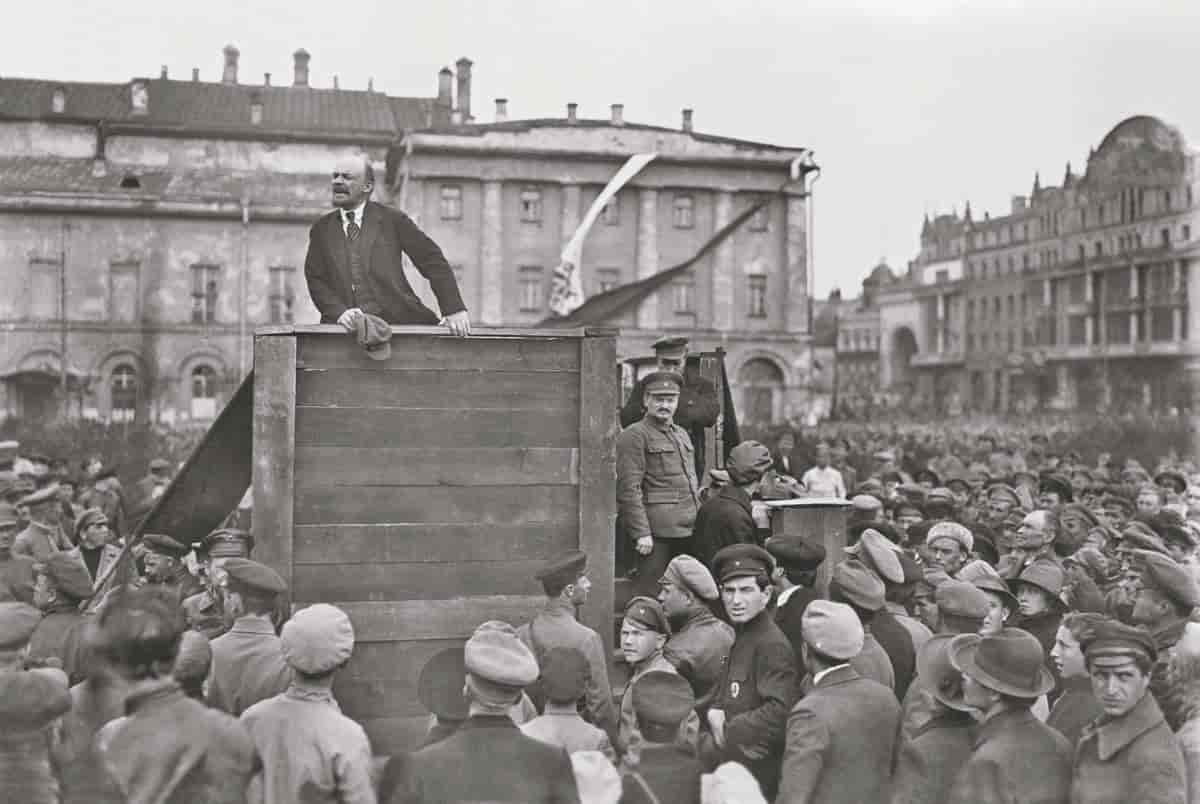 The brightest page in the struggle of the Kazakh people against tsarism was written in 1916. It lasted until late 1917, when Soviet authority was established in the area / Image: public domain
The brightest page in the struggle of the Kazakh people against tsarism was written in 1916. It lasted until late 1917, when Soviet authority was established in the area / Image: public domain
The 1920s saw the implementation of Lenin’s national policy by the Soviet power – a power that had been established by the joint struggle of the Kazakh peasants and Russian workers against the White Cossacks and bourgeois nationalists from the Alash-Orda government. In July 1919, the Kirghiz region (as Kazakhs were usually known until the mid 1920s), later the Kirghiz ASSR, was established, with its capital in Orenburg, then in Kyzylorda. In 1925, it was transformed into the Kazakh ASSR with Alma-Ata as its capital (as of 1927).
Although the Soviet authorities pursued a general policy of adapting the Kazakhs to a settled way of life – which ought to have led to an increase in culture and quality of life – the fact that it was impossible to feed livestock on winter pastures alone was also taken into account. By 1928, most of the Kazakhs were semi-nomads. Stalin’s collectivisation policy, which was carried out by Filipp Goloshchekin, was accompanied by 'sedentarisation', i.e. forcing Kazakhs into a sedentary collective farming way of life. For the most part, this policy was conducted on account of the difficulties the regime faced in controlling the nomads. In 1930-31, the exhaustion of pastures led to mass-scale dying of livestock. By 1933, no more than 4 million cattle were left of the 40 million that had previously existed.
Mass starvation was the result. According to various estimates, 1 million to 1.75 million people – about a third to a quarter of the Kazakh population of the republic – died of starvation. In addition, at least 1.38 million people emigrated from the republic, mainly to China. The word Asharshylyk, meaning famine, became proverbial. It should be noted that the death rate would have been even higher had 31.4 million tons of grain from the state reserves not been allocated for the nomads as food aid from September 1932 to 1934.
For decades, the bourgeois nationalists have attempted to portray Asharshylyk as a carefully planned crime of Stalin’s regime. But in reality, Boulez de la Merta’s catchphrase could not be more aptly applied here: “It was worse than a crime. It was a mistake.” By planning collectivisation among the nomadic peoples, the bureaucracy committed a series of blunders, which, in the absence of the opportunity for ordinary communists to criticise the decisions of the ‘centre’, led to a terrible tragedy.
At the same time, a number of Gulag work camps were established in the desolate steppes and semi-deserts of Kazakhstan. First there was the gigantic Karlag near Karaganda in central Kazakhstan, where large deposits of coal and iron ore had been discovered. One of its branches was the largest women’s camp in the USSR, the “ALZhIR” (Akmolinsk Camp for Wives of Traitors to the Fatherland). There, the wives of executed revolutionaries – leaders of the USSR in the 1920s (Bukharin, Krestinsky and many others) – as well as those of acting members of the government, including the formal head of the USSR – Kalinin, were imprisoned.
Kazakhstan was always seen by Stalin as a place of exile, beginning with the members of the Left Opposition and, above all, Leon Trotsky himself, who spent the whole of 1928 in exile in Almaty. Later, kulaks were exiled there during the period of collectivisation. After serving their sentence, the Karlag prisoners, who had no right to leave Kazakhstan, remained there. The largest forced migration to Central Asia, however, was a consequence of Stalin’s ethnic policies. This began in 1937, when the Korean population was expelled from the Far East. Subsequently, millions of Soviet citizens were driven from their homes and moved to less suitable areas, primarily to Kazakhstan, over a period of more than 10 years. These included Chechens, Ingush, Crimean Tatars, Ingrian Finns, but above all Germans.
Most of the nearly one million Russian Germans had been living in the Autonomous Republic of the Germans of the Volga region when it was liquidated at the end of August 1941. Unlike most of the other immigrants, the Germans, with their experience of farming in the arid steppes of the Volga region, began ploughing up the Kazakh black soil. This experience influenced Khrushchev's decision to begin the mass ploughing of the steppes of Northern Kazakhstan in 1954 – the ‘Virgin Lands’ campaign. In total, at least two million Russians and Ukrainians moved to the Virgin Lands. By 1960, half of all grain harvested in the USSR was grown there.
Independence
By the start of Perestroika, the Kazakh SSR was the only Soviet republic where the titular nation was an ethnic minority. At the time, the population of the republic consisted of 40 percent Kazakhs, 40 percent Russians, and 6 percent Ukrainians and Germans. There was an unspoken tradition in the USSR: the first secretary of the Republican committee of the CPSU had to belong to the titular nation of the given republic, while the second secretary would be a Russian or Ukrainian. After coming to power in 1985, Gorbachev immediately began his ‘rejuvenation’ of the Politburo of the Central Committee of the CPSU, replacing the old cadres with his protégés.
By the end of 1986, it was the turn of Dinmukhamed Kunaev, who was the party head of Kazakhstan. The main candidate considered for his replacement was the young chairman of the republican Council of Ministers, Nursultan Nazarbaev, patronised by Kunaev. In a surprise move, Kunaev sharply opposed his candidacy. Instead of Nazarbaev, he proposed the first secretary of the Ulyanovsk Regional Committee, Gennady Kolbin, as a temporary candidate. This was a man who not only had no knowledge of the Kazakh language, but had never even worked in Kazakhstan.
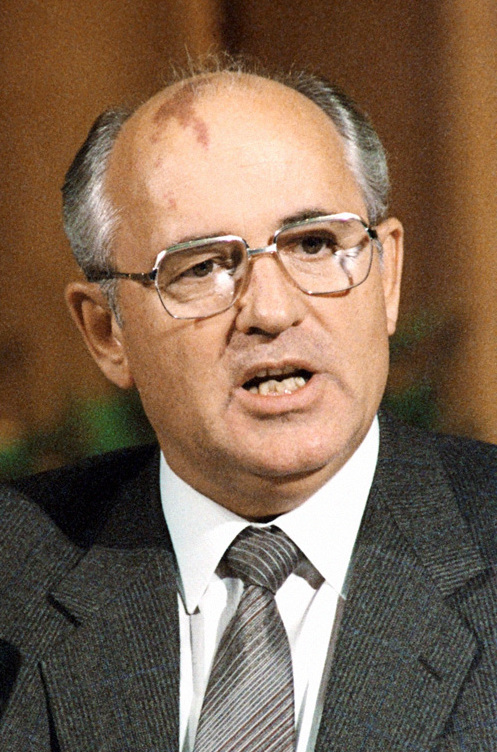 After coming to power in 1985, Gorbachev immediately began his ‘rejuvenation’ of the Politburo of the Central Committee of the CPSU, replacing the old cadres with his protégés / Image: RIA Novosti, Wikimedia Commons
After coming to power in 1985, Gorbachev immediately began his ‘rejuvenation’ of the Politburo of the Central Committee of the CPSU, replacing the old cadres with his protégés / Image: RIA Novosti, Wikimedia Commons
Such a choice on Moscow’s part outraged not only the local party bureaucracy, but also and especially the Kazakh intelligentsia and Kazakh student youth, who came out in protest to demand Kolbin’s resignation. A thousands-strong demonstration was held on Brezhnev Square (now Republic Square) on 16-17 December 1986. The Communist Party organisations of the biggest factories in the city formed workers’ militias, one member of which was killed during clashes with the protesters. Only by the evening of 18 December was the demonstration dispersed, chiefly by army units sent in from the European part of the USSR.
These events (known as ‘Zheltoksan’, Kazakh for ‘December’) undoubtedly led Nazarbaev to draw conclusions that would prove very useful in helping him hold onto power for many years. It is notable that in February 1986, at the 16th Congress of the Communist Party of the Republic, Nazarbaev had covertly criticised Kunaev for nepotism, wasting state funds, and economic failures. Some 36 years later, his own successor would treat him in an astonishingly similar manner.
Having become head of the party organisation in June 1989, Nazarbayev later became the president of Kazakhstan. Unlike many other leaders of the Republic, he consistently supported Gorbachev, and in one way or another spoke up for the preservation of the USSR, as did the leaders of the other Central Asian republics. At the All-Union referendum on the question of preserving the USSR in March 1991, only 5.2 percent of the inhabitants of the republic voted against. This is one fifth of the number who voted for dissolution in the RSFSR [Russian Soviet Federative Socialist Republic]. The decision of the three leaders of the Slavic republics to liquidate the USSR, adopted in Belovezha Forest in December 1991, put the leaders of the now-independent Central Asian republics in a very difficult economic and political position.
The prospect of creating a nation-state in Kazakhstan looked particularly uncertain. The country was clearly divided along ethnic lines into a ‘Russian’ (more precisely, Russian-speaking) north, where most of the national economy was concentrated, and a Kazakh south, the cultural and administrative centre of which was, again, the Russian-speaking capital, Almaty. Most of the Kazakh party nomenklatura (bureaucrats) came from the villages, and nepotism and corruption were rife among them. In addition, the division of the Kazakh people into three Zhuz (historical tribal associations) was and remains not only an element of self-identification, but also a factor in ‘clan-based’ factionalism within the elite.
Independent Kazakhstan, like the other republics of the former USSR, began its history in conditions of economic collapse. The disruption of economic ties, the lack of working capital, and the difficulty of converting the defence industry to civic uses were all exacerbated by the massive emigration of qualified specialists. During the 1990s, approximately 100,000 ethnic Germans repatriated to Germany each year. Over 200,000 Russians left for Russia each year. The migration of the Russian-speaking population was caused to a large extent by the collapse in machine-building industries and rising unemployment in industrial centres. The outflow of the population was partially compensated for by the state programme to repatriate about a million ethnic Kazakhs – the so-called ‘oralmans’ – from Uzbekistan, Mongolia, Turkmenistan, China, Russia, and other countries.
Petrostate
However, Nazarbayev also had serious advantages, particularly the mineral wealth of Kazakhstan, primarily oil and gas fields on the eastern coast of the Caspian Sea. A number of fields in the Mangystau region were developed in the days of the USSR. Meanwhile, the Tengiz oil field, discovered on the eve of Perestroika in the Atyrau region in Western Kazakhstan, is being developed by the US company, Chevron. In 2000, the even-larger Kashagan offshore field was explored and is being developed by a consortium of European companies.
Oil, gas and primary raw materials account for approximately 70 percent of Kazakhstan’s exports. Another 15-20 percent consists of ferrous metals, copper, zinc, vanadium and uranium ore. The only products with relatively high added value are cereals and oil-bearing crops from northern Kazakhstan. The textile and clothing industry in Kazakhstan has practically disappeared, unable to compete with Uzbekistan’s extremely low wages; and the engineering industry has not been able to adapt to the world market. This was compounded by the fact that Kazakhstan has consistently pursued a liberal economic policy since the mid-1990s, with the state refraining from intervening in the sector.
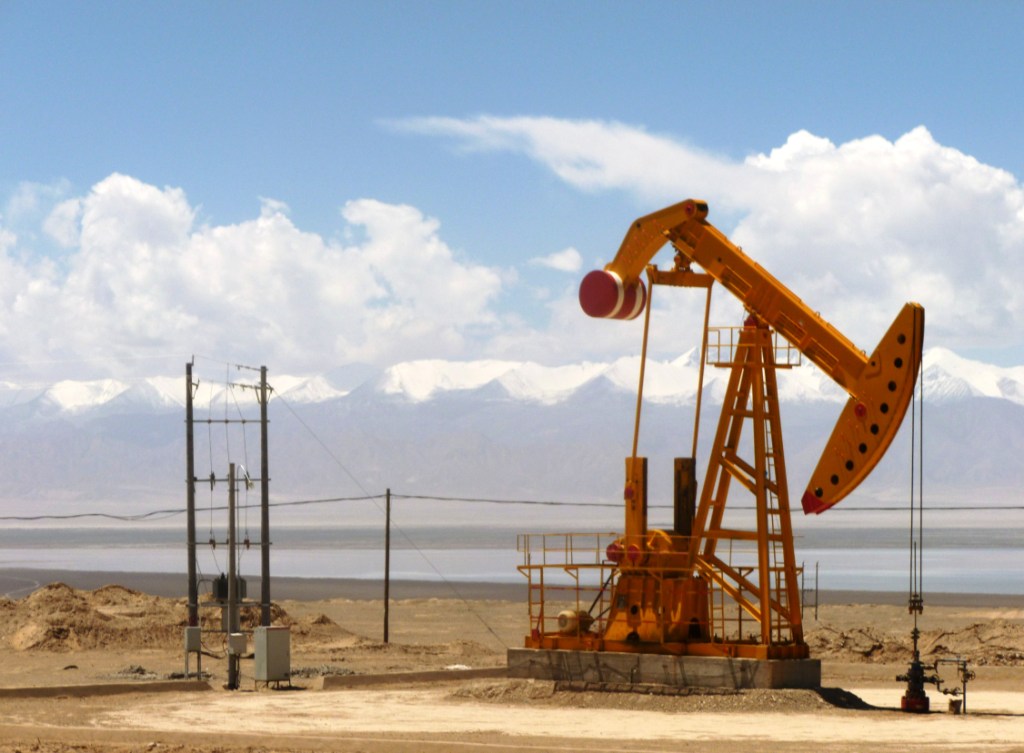 Oil, gas and primary raw materials account for approximately 70 percent of Kazakhstan’s exports / Image: John Hill, Wikimedia Commons
Oil, gas and primary raw materials account for approximately 70 percent of Kazakhstan’s exports / Image: John Hill, Wikimedia Commons
Kazakhstan traditionally leads the CIS in terms of foreign investment per capita, but the money is concentrated in the oil production of western Kazakhstan and, to some extent, in the metallurgy of the central regions, dominated by ArcelorMittal Temirtau. Meanwhile, the population of the country has grown fastest in the rural areas of the south of Kazakhstan, the industrial and agricultural potential of which remains underdeveloped under the conditions of a liberal economic model.
An interesting fact: the Alatau foothills are an ideal place for growing apples. Here, the Sievers apple tree grows wild – the ancestor of all modern apple varieties. In fact, the name of the city of Almaty comes from the Kazakh word ‘alma’, meaning apple or apple tree. In the 1970s, in the Alma-Ata region there were more than 3 million trees of the Aport variety alone. Yet modern Kazakhstan only exports apples in those years when the harvest is most bountiful.
As is common in commodity-exporting states (or ‘Petrostates’, as many are now fashionably called), oil windfalls (and corresponding infrastructure spending) have served to suppress the manufacturing sectors of the national economy. Thus, the gross domestic product of Kazakhstan in 2020 amounted to $163.23 billion, or $8,800 per person. That is only slightly less, per capita, than Russia. At the same time, however, the median salary (we specifically take the pre-coronavirus period) is less than $300 per month ($282 in the fourth quarter of 2018), while in Russia it was $528 in April 2019. Comparing average wages with Russia is particularly significant given that the countries are members of the Eurasian Economic Union (Customs Union) and share over 6,000 kilometres of common border, leading to a general trend towards equalising commodity prices.
But, taken in all, the oil boom completely transformed Kazakhstan. After the collapse of the 1990s, high oil prices in the early 2000s drove astonishing levels of GDP growth. Figures of 9-10% growth were consistently registered year after year. Growth then fell in 2008-09, without tipping Kazakhstan into recession, before recovering to levels of 5-7% per annum until the collapse of oil prices around 2014. Although most of this spectacular wealth extracted in this period was syphoned off by foreign capital and the Kazakh elite who are effectively their local agents, there was nonetheless a dramatic improvement in the household income of working-class people. Annual household income per capita has risen from little over $500 in 2000 to a peak of just under $4,500 USD in 2014. This was a key prop of the regime’s long-term stability.
But this dependence on oil income has come at a price. The national currency of Kazakhstan, the tenge, is even more dependent on oil prices than the Russian ruble. While the depreciation of the Russian ruble usually leads to export substitution and compensatory growth in the manufacturing industry, followed by an increase in wages, nothing like this has happened in Kazakhstan since 2014. Since the bust in oil prices in that year, household income per capita has fallen from its peak of $4,500 to below $3,500 2019. And that was before the pandemic. However, while wages have stagnated or fallen back, prices have continued to rise.
The weakness of Kazakhstan’s impressive economic performance has been laid bare. Until 2014, oil income allowed the ruling class to grant certain concessions to the working class, which it has had to cover since then by eating into state reserves. Government spending has increased year on year by an average of 20 percent in nominal terms, and there has been a corresponding decline in the resources of the National Fund of the Republic of Kazakhstan, the assets of which have fallen by 26 percent since 2014. Before the pandemic, the spending of these substantial reserves accumulated in the years of the oil boom masked the deep crisis that the country faced. All that changed with the crisis that accompanied the pandemic in 2020.
Increasing prices and the condition of the masses
In 2020, the US, China, and EU countries made huge cash injections into their national economies, in order to rescue them from the impact of the pandemic. This inevitably led to a depreciation of their national currencies and inflation. At the same time, falling yields on government bonds caused an increase in demand for futures on raw materials and food, which drove up prices for these goods.
But, as is usually the case, the first victims of this monetary policy by the advanced capitalist countries were not their own citizens at all. The rise in the price of fuel oil, grain and sunflower oil, which Kazakhstan exports, has also affected the domestic market for these goods. The increase in vegetable prices in the summer of 2021 ranged from 30 to 80 percent throughout the Eurasian Economic Union. But the position of Kazakhstan was even worse on account of the 12 percent depreciation of the tenge against the ruble. Together with 9 percent inflation, this added up to an increase in prices for Russian exports by 20 percent – Kazakhstan being the largest importer of Russian manufactured goods.
 The immediate catalyst of the current political crisis was the rise in prices for liquefied gas following the crisis triggered by the pandemic / Image: public domain
The immediate catalyst of the current political crisis was the rise in prices for liquefied gas following the crisis triggered by the pandemic / Image: public domain
Another factor driving inflation is the recent law allowing Kazakh citizens to withdraw part of their pension savings to buy real estate, which caused a sharp jump in property prices and a 30 percent increase in rent in large cities, despite the fact that renters’ salaries have remained the same. This has been a major blow to rural migrants, who tend to be renters.
But the immediate catalyst of the political crisis was the rise in prices for liquefied gas (LPG: a propane-butane mixture). LPG is widely used in many countries for cooking. Propane and butane are contained in large quantities in associated petroleum gas, which is released during oil production. In Russia and Kazakhstan, it is still sometimes flared during oil production on account of the difficulties transporting it. Its relative affordability in the EAEU countries has led to it being widely used as a motor fuel in several regions, especially in light commercial vehicles, and even for heating. Amid lockdowns in the summer of 2020, domestic demand for LPG fell, and its largest producer, Sibur, significantly increased exports. In the summer of 2021, domestic demand recovered and there was a shortage of liquefied carbon gas, which worsened as a result of an accident on 5 August at the Gazprom plant near Novy Urengoy.
As a result, the price of a litre of LPG at gas stations in Russia doubled for a short time, while the price of LPG in Kazakhstan is fixed and significantly lower than in Russia. This naturally led to a shortage of liquefied gas, especially close to the Russian border, as greater profits could be had by exporting it than by selling it at local prices. At the same time, the government of Kazakhstan, concerned about the budget deficit, was not ready to reduce LPG exports to China and Ukraine. It opted, therefore, to liberalise prices, which meant raising them to 120 tenge (about 30 cents per litre). This price may not seem high, but bear in mind that for owners of vehicles running on LPG, this meant a doubling of the cost of operating their vehicle. It was even worse for those who used liquefied gas for heating. In the midst of a harsh winter, their costs also doubled. In addition, the oil workers of the Mangystau region were naturally resentful at having to pay exorbitant prices for the same gas they had themselves extracted.
Wealth and poverty
Kazakhstan has a complex demographic composition. In the Caspian regions, where many oralmans were resettled, and in the small-scale agricultural south of the country, the total birth rate is more than three children per couple, while in the north it is less than two, and even then, this is mostly concentrated in the country's capital, Astana. The natural result of this is unemployment. Official figures put it at 5 percent, but with a minimum wage of only 42,500 tenge ($110), the actual level of unemployment and underemployment is higher.
On the one hand, the reserve army of labour puts pressure on the labour market. This is facilitated by the labour legislation of Kazakhstan, which is completely structured in the interests of bosses. Instead of retraining and relocating workers, transnational corporations carry out massive layoffs. For example, in the west of the country, in the Atyrau region, a region with high unemployment, plans were announced in December to lay off 40,000 workers from Tengizchevroil in 2022. All this leads to the stagnation of wages against a backdrop of rising prices. Atyrau was already the most expensive city in Kazakhstan to live in.
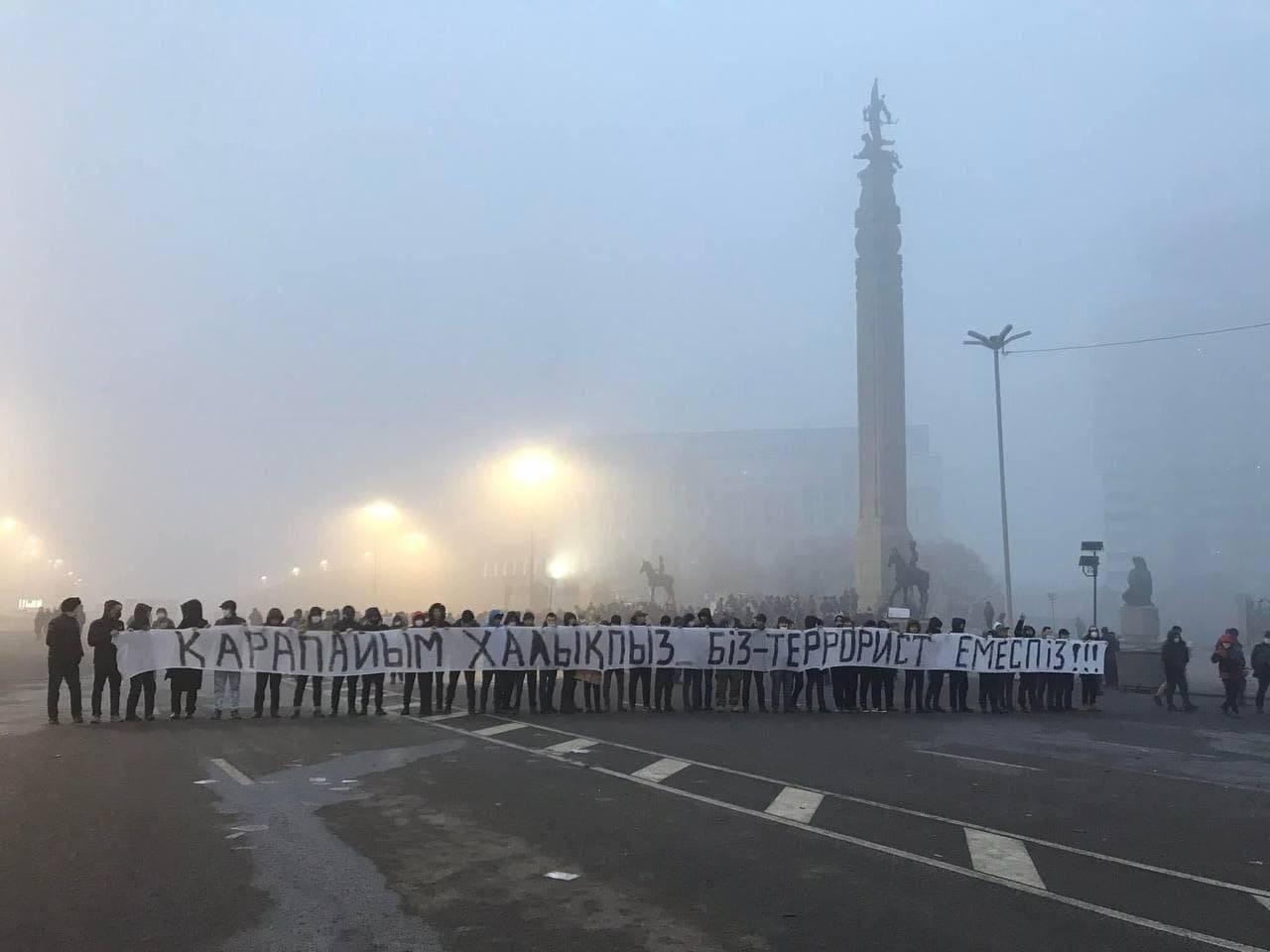 Unable to face up to what these protests say about Kazakh society, the intelligence agencies have made every possible effort to find a ‘foreign influence’ in the protests / Image: Twitter
Unable to face up to what these protests say about Kazakh society, the intelligence agencies have made every possible effort to find a ‘foreign influence’ in the protests / Image: Twitter
Mass migration is also swelling the population of the country’s capitals – Almaty and Astana. Around Almaty – especially on the western outskirts of the city and adjacent areas of the Almaty region – a belt of ghettos and even slums, has formed, in which about a million people live. Repeated attempts by the authorities to demolish illegally-built houses in the area were accompanied by desperate resistance from their inhabitants. Their residents, in the absence of good-quality education and with low levels of proficiency in the Russian language, are forced to take on the lowest-paid jobs. They are mainly employed in auxiliary work in construction and in small businesses. People from the slums find themselves building houses they themselves can never afford; carrying boxes of toys they cannot buy for their children; and guarding leisure establishments they will never make use of.
The revolutionary potential of these people is obvious. But it would be naive to expect perfect revolutionary discipline to emerge spontaneously. From the very first moment that shop windows were broken, we have been forced to listen to the moaning of the bleeding-heart liberals, squeamish ‘native Almaty residents’, and wealthy philistines about their ‘beloved city’ being ‘destroyed’ at the hands of ‘orcs’ and ‘migrants’, meaning those people who actively looted shops and shopping centres. But this revolt is the language of the most disadvantaged. How can one be surprised or lament these events, when both the state and private business have been looting and plundering the country on a national scale for 30 years now? Let us leave the reformists and pacifists to their laments.
None of this, however, is to say that looting of shops inevitably accompany revolutions, nor that they are desirable or take the movement forward. But it is obvious that the social composition of participants in the protests in Almaty, coupled with decades of harsh suppression of all open opportunities for class or political self-organisation, paved the way for this course of events.
Unable to face up to what these protests say about Kazakh society, the intelligence agencies have made every possible effort to find a ‘foreign influence’ in the protests. For example, Kazakh media published a video of a detained man with obvious signs of having sustained a beating to his face, who confessed on camera that he was paid 90,000 tenge ($200 US dollars) to participate in the riots. The man stated that he was unemployed and arrived from Kyrgyzstan. However, TV viewers quickly recognised him as Vikram Ruzakhunov, the leader of a jazz orchestra from Bishkek. Near the embassy of Kazakhstan in Bishkek, a rally was held in support of the framed jazzman. The absurdity of what was happening was so obvious that Vikram was released.
Unfortunately, not all the Kyrgyz detained by the police in Almaty last week are famous musicians. The truth is that there is no significant difference between the Kyrgyz youth from the suburbs of Bishkek, who have overthrown the rulers of Kyrgyzstan over and over again, and the Kazakh youth from the suburbs of Almaty. The Tokayev regime survived only because Kazakhstan is larger and more heterogeneous than Kyrgyzstan.
The nature of the regime
A few comments are in order about the nature of the regime in Kazakhstan. Despite the superficial similarity between the autocratic regimes of Putin in Russia and Nazarbaev-Tokayev in Kazakhstan, there are significant differences between them. Putin came to power amidst the economic and political collapse of Yeltsin's oligarchic regime. Faced with a real threat of losing their fortunes, the oligarchs allowed the establishment of a Bonapartist regime, thereby losing their immediate political control over the state. Putin has risen above the classes, including the bourgeois class that established itself in the previous period of the bourgeois counter-revolution. Of course, this process proceeded with the participation of the state, but the privatisation of the mid-1990s in Russia was a two-way road. The state depended on the oligarchs no less than the oligarchs on the state. This co-dependence was embodied in the 1996 presidential election.
In Kazakhstan, the situation was different. The country's ruling class was also artificially created, with the help of American advisers, from among the friends and relatives of Nazarbaev, just as the country’s political elite was artificially nurtured in its new capital, Astana (formerly Tselinograd, based in the grain belt in the north of the country). Unlike Putin, Nazarbaev has never even so much as demagogically claimed to offer the working class protection from the capitalists. On the contrary, he always emphasised, with extreme cynicism, that his central concern was the country’s attractiveness as an investment opportunity for foreign capital.
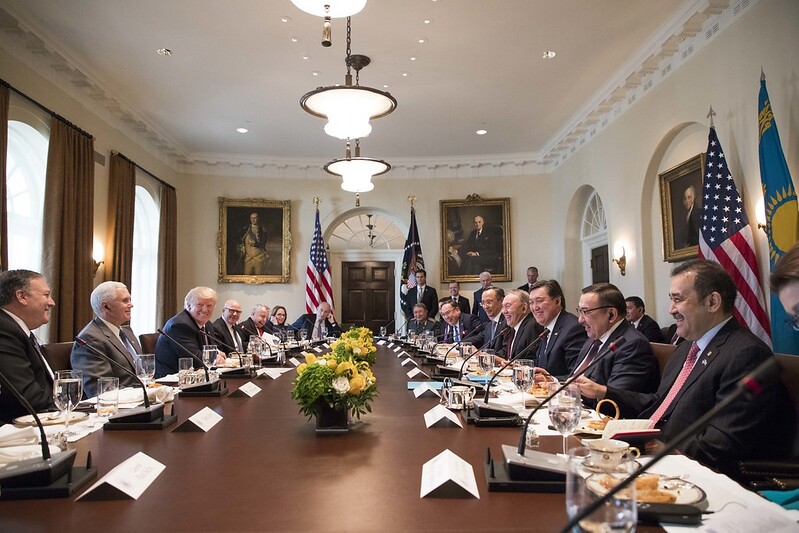 Kazakhstan ruling class was also artificially created, with the help of American advisers, from among the friends and relatives of Nazarbaev / Image: public domain
Kazakhstan ruling class was also artificially created, with the help of American advisers, from among the friends and relatives of Nazarbaev / Image: public domain
The whole history of modern Kazakhstan is one of struggle by the regime against the labour movement, with the persecution of trade union activists, suppression of labour struggles, and the forceful takeover and liquidation of independent trade unions. In the early 1990s, the Karaganda coal basin was the epicentre of this struggle, because the trade unions gained great influence after the miners' strike of 1989. The only result of the subsequent miners' strike on 5 May 1995, which was accompanied by the seizure of mines and a hunger strike, was the liquidation of most of the mines by Nazarbayev and their transfer, free of charge, to ArcelorMittal Temirtau. The state did not give the miners a penny.
At the beginning of the 2000s, the focal point of the workers' struggle moved to the west of the country, which since 2001 had seen a battle for the creation of independent oil workers' unions. Since 2008, there have been regular strikes by oil workers. Since 2010, a labour conflict has been raging at the Karazhanbasmunai oil company, in the course of which the bosses’ thugs have beaten and killed trade union activists, and set their houses on fire. Strikes continued throughout the summer and autumn of 2011, during which hundreds of workers were fired, and three trade union activists, including union leader lawyer Natalia Sokolova, were convicted of various crimes. Finally, on 26 December 2011 in Zhanaozen, at least 15 protesters were killed (according to official figures), and hundreds injured during clashes between striking oil workers and police. Several hundred people were arrested.
None of this is to say that over three decades, the only support Nazarbaev has enjoyed has come from the state apparatus, the army and the police. No regime can last for so long through police methods alone. Rather, the same boom in the 2000s – which allowed the ruling class to make certain concessions to the working class, bolstering its stability for a time – has also massively strengthened the working class, above all in the oil sector, which has increasingly come into conflict with the regime. As Marx explained long ago: capitalist investment and development also summons into existence capitalism’s own gravediggers.
But more than this, Nazarbaev's regime has relied on provoking mutual distrust between ethnic Russians and Kazakhs. On the one hand, the position of the Russian minority in Kazakhstan has always been comparatively comfortable. The Russian language is not only used in everyday communication, but also in official office work.
There are many Russian and mixed schools across the country where classes are in Russian, and to which many Kazakhs willingly send their children. Higher education can be obtained for free in Russian. But according to the 2009 census data, only 6.3 percent of Russians are able to read and write in Kazakh, and less than 20 percent are able to understand Kazakh speech to any extent. Given that the Russian population of Kazakhstan is rapidly ageing, there is no reason to believe that these numbers have changed much in 10 years. On the other hand, 20 percent of ethnic Kazakhs, primarily rural youth, do not know Russian, which significantly limits their employment opportunities.
The Bonapartist elite of Kazakhstan is trying to present itself to ethnic Russians as the guarantor of their security, and to the Kazakhs as a force capable of negotiating with a dangerous and unpredictable Russia. Such demagogy is becoming less relevant in modern Kazakhstan as the Russian population rapidly declines, but it has been used for many years as a rationale for an autocratic style of government and a ban on almost all opposition parties.
A boiler without a valve
The political system created by Nazarbayev does not allow for any meaningful opposition. Under the pretext of ensuring civil peace, all ethnic, religious, and communist parties have been consistently banned.
The Communist Party of Kazakhstan (KPK) split in 2004 after joining the electoral bloc ‘People's Opposition Union of Communists and the DCK [Democratic Choice of Kazakhstan]’ in the parliamentary elections. A Communist People's Party of Kazakhstan – in reality a regime puppet – was created from the party minority. However, it could not get into parliament until the genuine Communist Party was first deprived of the right to participate in the 2012 elections, and then, in the same year, completely denied registration.
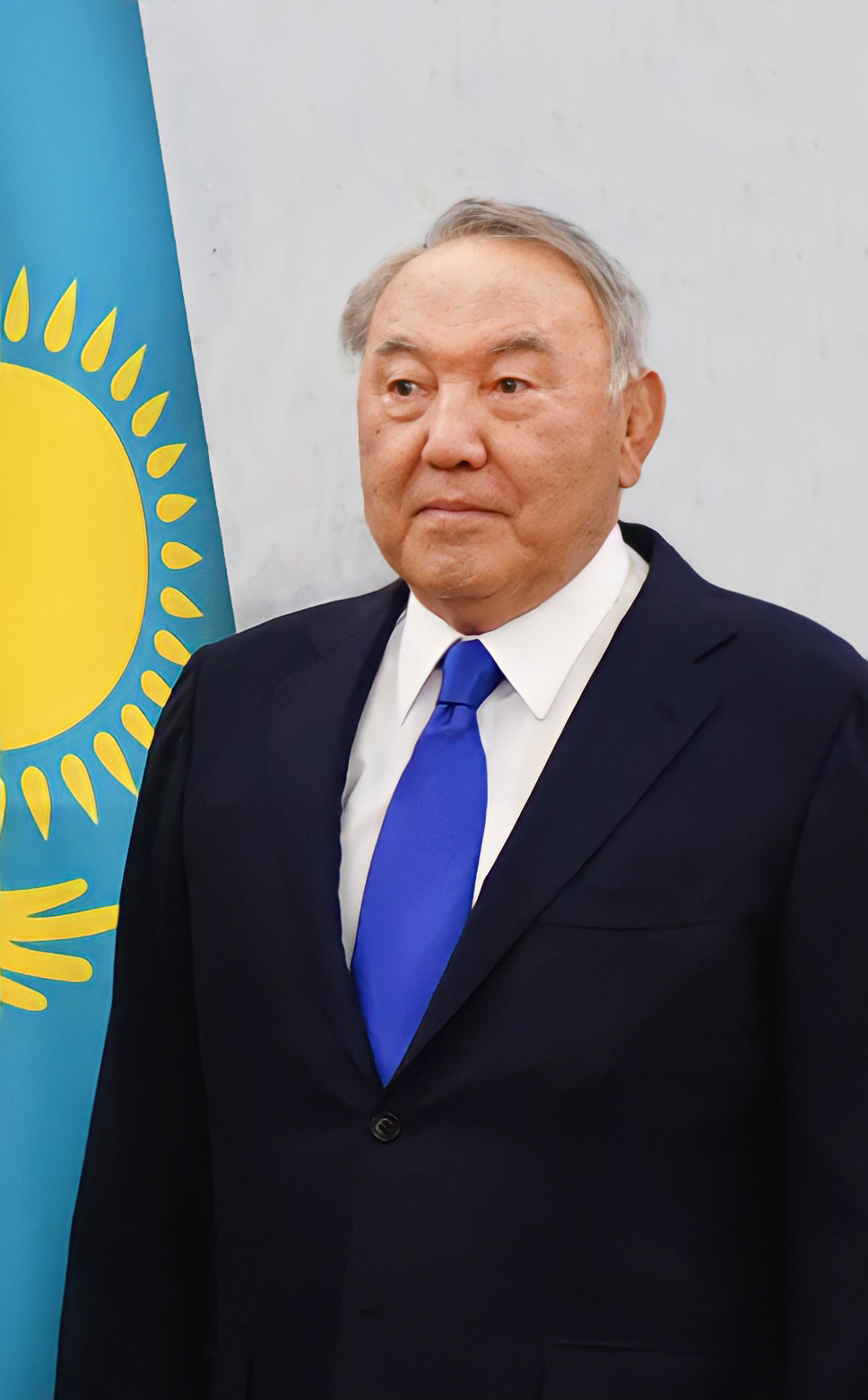 Under the pretext of ensuring civil peace, all ethnic, religious, and communist parties have been consistently banned by Nazarbayev / Image: Пресс, Wikimedia Commons
Under the pretext of ensuring civil peace, all ethnic, religious, and communist parties have been consistently banned by Nazarbayev / Image: Пресс, Wikimedia Commons
Arrests and occasional killings of opponents of the regime are common practice by Kazakhstan's special services. The opposition parties, Democratic Choice of Kazakhstan and Alga!, were also banned by the authorities along with Islamist parties such as Hizb ut-Tahrir al-Islami. Even so, these two so-called opposition parties do not offer any fundamental alternative to the masses. The leader of Democratic Choice of Kazakhstan for instance, Mukhtar Ablyazov, is an oligarch and an old pal of Nazarbaev who fled to Europe after he fell out with him.
Formally, six parties are registered in Kazakhstan, but only three are represented in parliament: the pro-presidential ruling Nur Otan (Light of the Fatherland) party, which has an absolute majority of seats, and two ‘constructive opposition’ parties created by splitting other political forces which were considered to be too oppositional to Nazarbaev – the right-wing ‘Ak Zhol’ and the left-wing People's Party, which recently ditched the word ‘Communist’ from its title. Today, a significant number of well-known Kazakh opposition leaders are in exile.
Following the suppression of the independent press, a few years ago Kazakhstan began restricting access to the opposition's internet resources. Internet users were required to voluntarily renounce their secrecy of correspondence by installing a special digital certificate in the list of trusted certificates on their computers, among other measures. During the recent protests, the internet was simply shut off.
However, these mass protests have shown that tightening the screws is by no means sufficient to ensure the security of the regime. Spontaneous protests were accompanied by spontaneous self-organisation. Political and social activists, and citizens who are simply dissatisfied, gathered in the central squares of cities, sometimes setting up tents and yurts. The workers established links and synchronised their demands, including political ones. Although the protests have been suppressed, their suppression had little to do with the severity of the regime itself.
The muscle of the Russian military was clearly key to stabilising the regime, but this also does not explain how the regime has temporarily stabilised the situation. To restore order, the government has had to resort to the carrot as well as the stick. The Kazakh establishment has to attempt to maintain at least a veneer of ‘democratic’ legitimacy. The country's leadership is more afraid of the masses than ever, and they know they cannot rest on bayonets alone. As such, we’ve seen that the massive repression of recent days has been accompanied by some economic concessions to some groups of workers, with wage increases of 10 percent, 50 percent or more in some cases.
Promises of greater political freedoms are likely to remain as little more than verbal concessions. At the beginning of his reign, Tokayev promised that he would grant greater freedoms – but the fact is that these have not materialised, either in terms of rights to organise politically or industrially. Most likely, the promised freedoms will never be granted so long as this regime exists, and as the pressure on the working class rises, the regime will find that it is like a boiler with the valves sealed shut. Eventually it must explode. Moreover, given the dependence of Kazakhstan’s economy on world market prices of raw materials, this is likely to happen sooner rather than later.
Transition of power
The old age of the permanent president – in this case, the ‘leader of the nation’ (‘Elbasy’ in Kazakh) – presents a serious problem for any Bonapartist regime: the problem of succession. Unlike former Azerbaijani President Heydar Aliyev, Nazarbaev has no sons. Nazarbaev did not dare hand over the reins of government to his eldest daughter Dariga, who at one point was elected chairman of the upper house of parliament, and is now a deputy of the lower house.
By appointing Kasym-Jomart Tokayev as his successor in 2019, Nazarbaev made a compromise decision. Tokayev studied in Moscow, then worked for 15 years at the Foreign Ministry of the USSR as a professional diplomat. He headed the Ministry of Foreign Affairs of independent Kazakhstan. At one point he was prime minister, but he never really belonged to any of the ‘clans’ or factions of the ruling class and political elite, nor did he have his own significant circle of close associates. This is obviously a politician acceptable to Moscow. But, he lacks the connections and influence that Nazarbaev enjoys among Kazakhstan’s elite, from which his authority ultimately flows. Without a firm hand at the top, splits within the political elite of Kazakhstan and the ruling class become increasingly probable – something that would have been unthinkable under Nazarbaev.
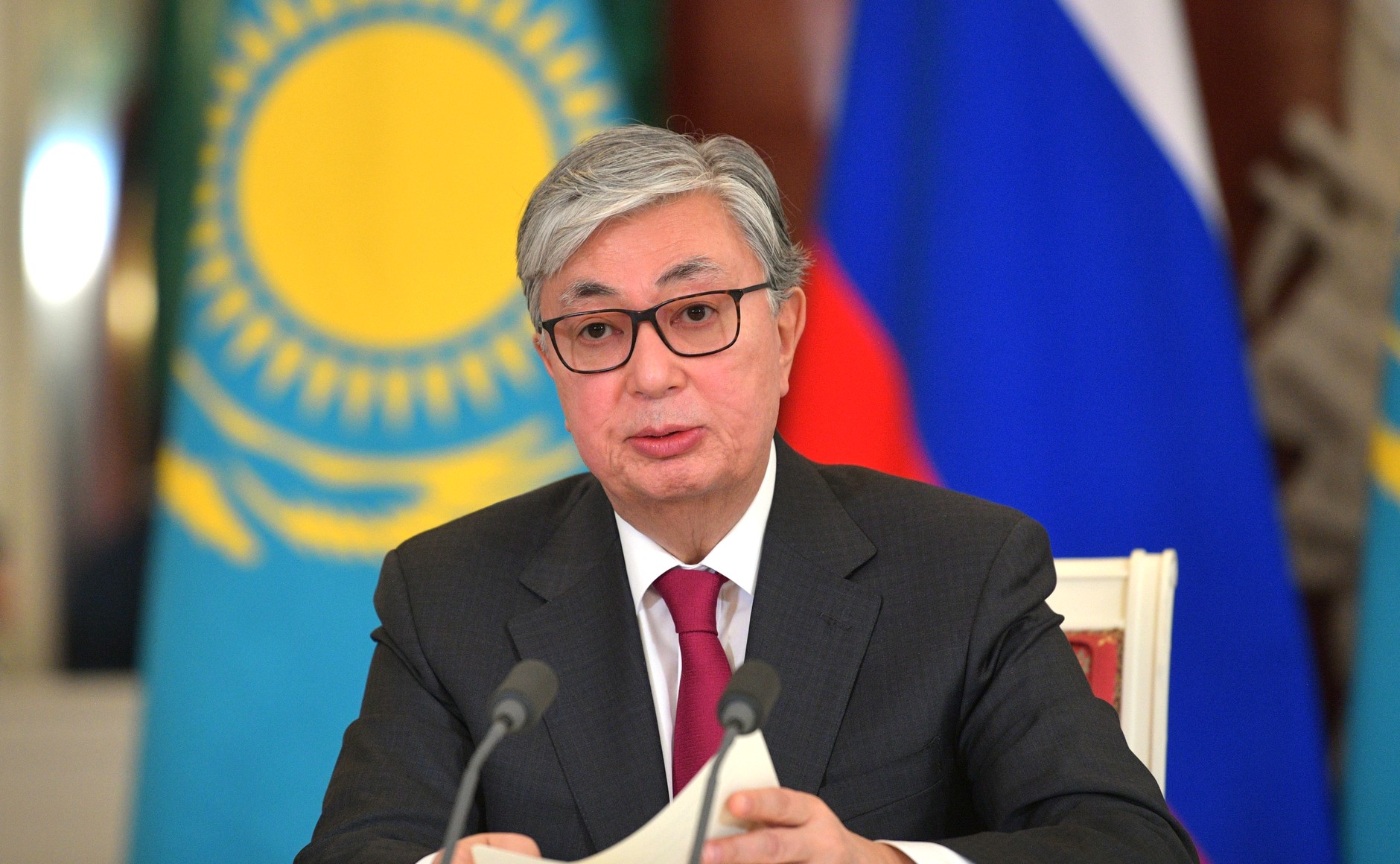 Tokayev lacks the connections and influence that Nazarbaev enjoys among Kazakhstan’s elite, from which his authority ultimately flows / Image: kremlin.ru, Wikimedia Commons
Tokayev lacks the connections and influence that Nazarbaev enjoys among Kazakhstan’s elite, from which his authority ultimately flows / Image: kremlin.ru, Wikimedia Commons
The first decision of the newly-appointed President Tokayev, taken almost immediately after the ‘transition’, was to rename the capital to Nur-Sultan. This name has not taken root and is rarely used outside of official documents. Tokayev himself was given the nickname ‘furniture’ and acquired a reputation as a weak, nominal ruler who lacked real power. De facto power remained with Nazarbayev, and to a large extent so too did de jure power, by virtue of his lifelong right to hold the post of chairman of the country's Security Council.
All the more surprising then were Tokayev's words in a televised address dated 5 January: “As the head of state and, from today, the chairman of the Security Council, I intend to act as tough as possible.” Considering that, by that time, Nazarbaev himself had not appeared in public and had not made any appeals (and still hasn't), it all looked like, if not a coup, then at least as a serious shift in the balance of power within the regime. This impression only seemed to be confirmed by the news of the removal of the head of the KNB, Karim Masimov. He is a close associate of Nazarbaev and former prime minister of the country, and is now in custody on suspicion of treason. Combined with the apparent inaction of the KNB in the January events, this immediately prompted many commentators to associate the uprising with an attempt by Nazarbaev's circle, and, above all, by Masimov, to remove Tokayev from power.
Others, on the contrary, tend to see the initiative of the current president in the events that transpired. This, of course, grossly underplays the role of the masses, who pushed ahead throughout the week of protests, forcing the regime to repeatedly beat a retreat. However, it is also clear that the movement exacerbated the conflict between the different wings of the ruling class, which attempted to use the protests to strike blows against each other. Whatever palace intrigues might have been opportunistically set in motion by the parasites and bloodsuckers in power, the mass uprising in these January days was not the product of some kind of conspiracy or coup. It obeyed its own logic.
In any case, the ‘old man’ and the most important members of his entourage and family have been pushed away from power. The long absence of Nazarbaev himself was telling. He had not made any direct public utterances until 18 January, and only once did his spokesman say that the first president voluntarily handed over the post of chairman of the Security Council to Tokayev, and called on citizens to rally around the incumbent president. Dariga Nazarbaeva also has not appeared in public (her assistant claims that she is on sick leave, “at home in Almaty”). Aliya Nazarbayea (the youngest daughter) has written on Instagram (apparently while in the UAE) that she “is grateful for the moral support of her father at the moment”. His influential younger brother, Bolat Nazarbaev, has also reportedly fled to Dubai via Kyrgyzstan. Furthermore, all three of Nazarbaev’s sons-in-law have been removed from their head posts in Kazakhstan's state oil and gas companies and from the national chamber of entrepreneurs – an important and influential representative organ of the national bourgeoisie. When Nazarbaev himself was finally wheeled out on 18 January for a recorded public address, he did not say much beside claiming that he was (and had been since 2019) simply a 'pensioner', and reassuring the public that there was no conflict within the elites, and asserting that the incumbent president has full authority.
However, it is significant that the ‘victory’ of the successor over the predecessor remains strictly unspoken. For instance, the Ministry of Information demanded that the regional news agency Fergana take down an article titled, ‘Terrorist Transition’, in which the author discusses the factional squabbles of the Kazakhstani elite. After all, an open admission that “the pleasures of the mighty are the tears of the poor” would be utterly embarrassing for the regime, and would seriously harm its legitimacy.
Imperialism
Until 2014, the question of the Russian minority in Kazakhstan was on the fringes of the political agenda in Russia, and was monopolised by fringe figures like Zhirinovsky and Limonov. At the beginning of the 2000s, the Russian establishment believed that oil prices would rise indefinitely and that petrodollars would be enough to cover all government spending. On 6 November 2007, after signing a decree on the construction of the Vostochny cosmodrome in the Amur region, Putin admitted that he was ready to cut the Gordian knot linking Russia and Kazakhstan, abandoning the Baikonur cosmodrome located in Kazakhstan in the future. However, the 2008 crisis and the resulting drop in oil prices forced Putin to take the non-extracting sectors of the economy more seriously. Although the Customs Union between Russia, Belarus and Kazakhstan was formally signed back in 1995, for the first 15 years it remained a dead letter.
Only in 2010, with the abolition of customs borders, did Russia begin making efforts to attract other CIS countries, primarily Ukraine, into joining the union. Ultimately, this led to a clash of interests between the EU and Russia, and the Euromaidan in Ukraine. Defeated in Ukraine, Putin only managed to convince Armenia and Kyrgyzstan, two very small economies, to join the union.
It is obvious that Russia is unable to compete with the US, the EU or China in the capital market – in terms of direct investment in the economy of Kazakhstan, Russia shares a measly fifth place with China. Indeed, Kazakhstan is a playground for imperialism: 70% of investment in Central Asia flows into Kazakhstan, amounting to $350 billion dollars in the last two decades. First, among those investors are the Netherlands, United States, Switzerland and China respectively. Despite its proximity, Russia is only the fifth biggest investor in Kazakhstan.
The only role that Putin can play for Tokayev is that of Nicholas I – i.e. to act as a gendarme. It remains to be seen what promises were made to Putin in return for his support. Notwithstanding any quid pro quo between Putin and Tokayev, Putin clearly has domestic reasons for intervening in Kazakhstan: the growing anger and frustration of the Kazakhstani workers mirrors that of their Russian brothers and sisters.
It is clear that, in the short term, the development of events will strengthen Russia's position not only in Kazakhstan, but throughout Central Asia. But people do not like gendarmes – the more actively Putin gets involved in the affairs of Kazakhstan, the greater will be the discontent of both the ruling class of Kazakhstan and the Kazakh working people. In addition, the intervention of the CSTO contingent, for the most part consisting of Russian troops, risks complicating the inter-ethnic situation in Kazakhstan.
Among other things, the January uprising once again confirmed the status of the weak and dependent nature of the Kazakhstani regime, whose main role is to protect property rights and interests of transnational capital. As described earlier, for decades the bourgeois government has been crushing trade unions and keeping the bulk of the population in subjugation and poverty – in other words, creating a good investment climate for a country specialising in extracting and exporting raw materials. In relation to the January events, an ‘unholy alliance’ of all the main imperialists of the region and the world has formed to support the current government, including the Russian Federation, the USA, the EU, China and Turkey. Such rare unanimity is due to the fact that all international players are satisfied with the state of affairs in modern Kazakhstan, and the prospect of the masses winning their economic and democratic demands poses a threat not only to Kazakhstani capitalists, but also to those overseas.
Prospects and the path to victory
The hot phase of the uprising is over and a period of cooling-off and reflection is beginning, during which all parties involved will have to assess what happened, draw the relevant lessons and look to the future.
From the very beginning of the January crisis, the regime has applied a combination of concessions and repressive measures. The authorities have no other choice but to continue similar tactics in order to attempt to restore at least part of their legitimacy and to strengthen their position. Tokayev's speech before parliament on 11 January is indicative of this approach.
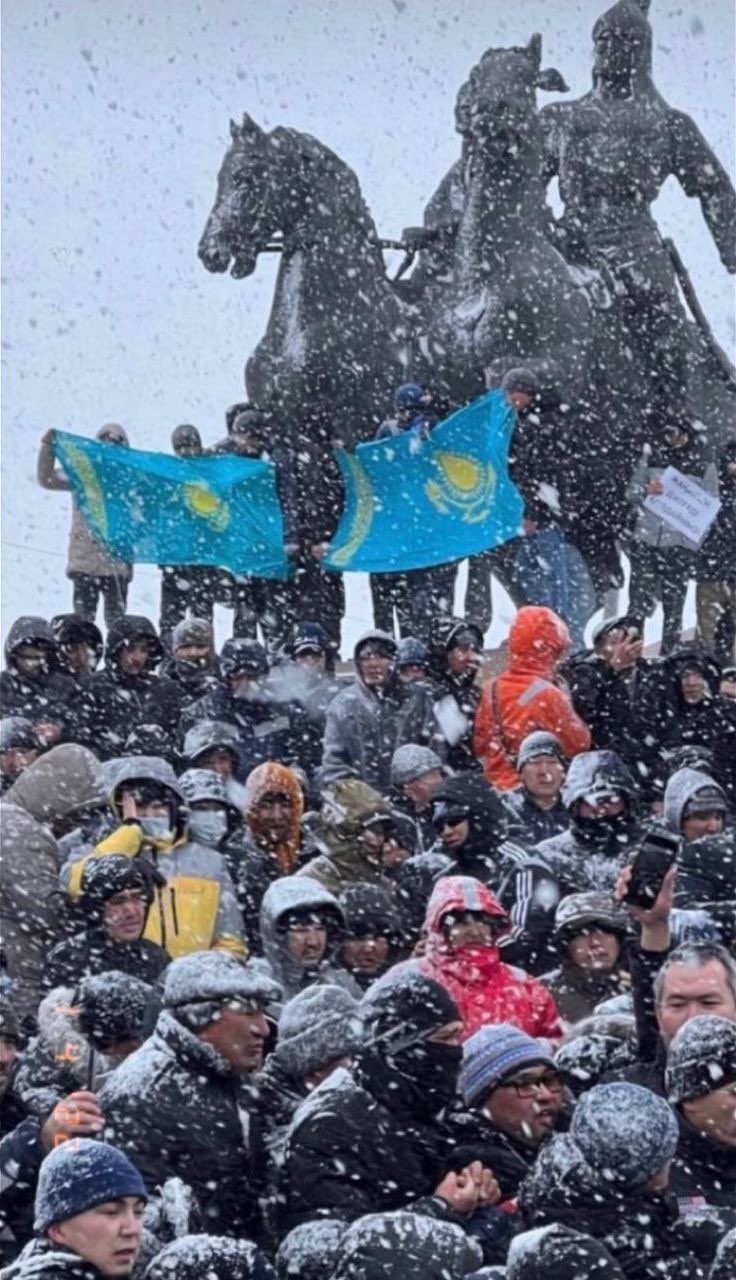 The protests quickly gained a truly revolutionary and – most importantly – nationwide character / Image: fair use
The protests quickly gained a truly revolutionary and – most importantly – nationwide character / Image: fair use
On the one hand, the president appealed to the bourgeoisie, the wealthy layers, and the frightened middle-class citydwellers. To this end, a whole range of measures has been announced to strengthen the security forces, which will include a huge increase in their funding for technical modernisation, greater manpower and a significant increase in salaries. After all, the January events showed that even many in the security forces are not loyal to the government and often do not want to defend it.
Much more importantly, Tokayev emphatically adopted rhetoric emphasising social justice and criticism of inequality in society, coupled with direct and indirect attacks against “financial oligarchic groups” as “key beneficiaries of economic growth”. The political elites within Kazakhstan were also targeted, being explicitly accused of corruption and using state funds for personal interests. In the words of Tokayev: “we know everyone [involved in corruption] by name”. Although he did not actually mention a single name, his speech included a veiled attack on Nazarbaev: “Thanks to the first president, Elbasy, a group of very profitable companies and a layer of people rich even by international standards appeared in the country. I believe that the time has come to pay tribute to the people of Kazakhstan and help them on a systematic and regular basis”. He stopped short of openly stating it, but clearly suggested that Elbasy and his family have been removed from power. Tokayev is trying to convince the public that the main obstacle, in the form of the old corrupt autocrat, has been removed, and that the incumbent president, having gained full power, will finally be able to ‘put things in order’, implement urgent reforms and fight against corruption.
To a certain extent, this gambit has worked. In Kazakhstan today, one can observe a fairly wide range of reactions to Tokayev's speech – from enthusiastic approval to cautious interest – reflecting a significant layer of public opinion that is, in general, ready to give some measure of confidence to the president to one degree or another, or at least grant him a ‘trial period’ to see if he fulfils his promises.
But these illusions will soon be dispelled, both by the peculiarities of the political system of Kazakhstan and by the reality of the capitalist market economy, of which Tokayev remains a firm defender. Firstly, it is not entirely clear to what extent he will be able to assert his authority among the various factions and ‘clans’ of the establishment in Kazakhstan. Judging by the very modest reshuffles in the government and the state apparatus undertaken thus far (apart from large-scale purges in the structures of the KNB and, to a lesser extent, the Security Council), the president is either unable or unwilling to take serious measures. Among his announced reforms, there was not a single one that could be called ‘democratic’.
Secondly, the ruling class has neither the material means nor the tools to accomplish any serious, long-term improvements in the socio-economic sphere either. It is already known that the regulation of prices for autogas and other vehicle fuels, announced in the very first days of the protests, will be carried out by covering the costs of the private sector, i.e. compensating businesses for the difference between the real market price and the retail price. Funds to make up the shortfall will come from the state treasury, and ultimately from the value produced by the working class of Kazakhstan. This should be a telling lesson that true price regulation is impossible in a market economy.
It is still unclear what measures Tokayev intends to take in pursuance of his promises to increase the income of the population, reduce unemployment and create social mobility. Some notable victories in terms of wage increases have already been achieved by strikes and other militant action by the workers of the Tengiz oilfields, and several industrial enterprises in the Aktobe region in the west of Kazakhstan, which is sure to be a source of inspiration and a lesson of class struggle for other workers in the country. However, for three decades now, even more than corruption and embezzlement, social advancement for the people has been hindered by the bitter political and economic reality of the capitalist system, and Kazakhstan's position in the world market as a raw materials exporter. Finally, the Kazakh economy has long suffered from high inflation, and the situation is only getting worse. Whether the authorities choose to continue intervening in the currency exchange, for which they spent $240 million on 12 and 13 January alone, or to allow the exchange rate to enter freefall, the consequences for the financial situation of citizens and for the state budget will be severe.
Far from being able to meet the socio-economic demands of the country's working class, the Tokayev government is powerless to even stop the deterioration of its own financial situation. In such a situation, retaining power will depend increasingly on repression. The regime was not afraid to drown the January uprising in blood. A wave of arrests has already hit journalists and activists who took part in or simply reported on rallies in various cities. The Ministry of Internal Affairs reports that it has detained thousands of ‘terrorists’ (as of 11 January, the official figure was close to 10,000 arrests), charges against whom include rioting, sedition and crimes under the terrorism articles of the criminal code. It is possible that, as in Belarus, we will soon face arrests and prison terms simply for liking and sharing material on social media. It is also likely that the authorities will attempt to split the movement and divide the dissatisfied sectors of society along various lines – ethnic, religious and regional – in order to divert the revolutionary potential of the Kazakh proletariat into the destructive channels of nationalism, religious fundamentalism and even tribalism.
This makes it all the more urgent for workers and youth of Kazakhstan to draw lessons and conclusions from the revolutionary confrontation that swept the country, and prepare to continue their struggle to the bitter end. The January uprising was not a single movement. Various social groups: workers, intellectuals, youth and the poor of the city outskirts and suburbs entered with different experiences of political struggle, and most often without any experience at all. Had the cohesion and organisation of the workers, the resilience of the old political activists, and the determination and uncompromising spirit of the youth and the poor flowed into a single channel, the Tokayev regime would have been left without a chance. Such unity was not achieved due to the lack of a clear sighted leadership. These main forces of the protesters were divided socially and even territorially. The working class was unable to organise and discipline the youth, while purely economic protests in Kazakhstan cannot be successful without a democratic and socialist agenda.
The main political slogan of the protests “Shal, ket!” (“Old man, get out!”) now speaks to the past. Nazarbaev is gone and will not return. Now, this slogan covertly legitimises Tokayev and his regime. We need new, positive slogans for the social transformation of society on democratic lines. Demands to stop repression, release political prisoners and detained activists, and provide complete freedom of labour and political organisation are coming to the fore. The labour movement should embrace the widest possible layers of the working masses and offer its own solution to their main problems. It must first of all put forward transitional demands: the nationalisation of the extractive, manufacturing and financial sectors of the economy; organised expropriation of all oligarchs; and full public control over law enforcement agencies, up to their dissolution and replacement by the people's militia to maintain law and order. The left intelligentsia must pave the way to the masses, including the most backward elements. It must speak the language of the masses; it must find a form of political expression that connects with the aspirations of the masses. If this happens, then the revolutionary movement of the working masses of Kazakhstan will be unstoppable!

